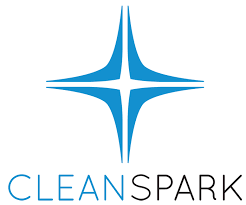[ad_1]
CryptoCorner
A microgrid company in Woods Cross, Utah may have a solution for Elon Musk‘s sustainability challenge for Bitcoin mining.
“Cryptocurrency is a good idea on many levels and we believe it has a promising future, but this cannot come at a great cost to the environment,” Musk tweeted. “Tesla has suspended vehicle purchases using Bitcoin (because) we are concerned about rapidly increasing use of fossil fuels for Bitcoin mining and transactions, especially coal, which has the worst emissions of any fuel.”

CleanSpark.com
CleanSpark uses microgrid technology in an effort to boost the efficiency of Bitcoin mining operations and other applications.
The existing grid delivers power from a generating plant to users. For most users, connecting to the grid is as simple as inserting a plug into a wall socket.
Microgrids combine the traditional grid with solar, wind, fuel cell and other green technologies to balance load requirements among various sources in an effort to assure clean energy at a good price.
Microgrids might be a build-to-suit answer to growing concern about the source of energy used in Bitcoin mining. Configuration of the system and the software needed to run it can be designed to meet specific demands, including future growth.
CleanSpark is also a Bitcoin miner, and recently invested in new energy-efficient equipment to boost its hash rate and cut electrical usage.
The company is publicly traded, but so far is covered by only two analysts. CleanSpark’s stock recently fetched $16.51 a share. The consensus price target, or estimate of fair value, is $47.50.
Competitors include Tata Power Solar, Longi, Acme Climate Solution and d.light design.
A report by Navigant Research, a Boulder, Colorado-based firm, said the market for modular microgrids is expected to grow at a 28% compound annual rate between 2020 and 2029.
“Although they are a minority portion of the market if measured by peak capacity, modular microgrids have the potential to make up the majority of systems deployed over the next decade,” Peter Asmus, Navigant’s research director, said in a report. “Taking a modular approach is expected to help radically scale up microgrid deployments by commoditizing standard microgrid offerings that can be pieced together, thereby shrinking design and deployment costs.”
The Crypto Climate Accord, based on the Paris Climate Agreement, is a private sector initiative seeking to decarbonize the cryptocurrency industry.
“For climate advocates, we can eliminate emissions from a fast-growing source of electric load,” the accord states. “For the clean tech industry, we can onboard an entirely new class of customers with significant demand for low-carbon solutions. For the crypto industry, we can help support widespread adoption of crypto by making the industry more sustainable.”
It’s signed by major companies in the sector.
Cambridge University’s Center for Alternative Finance estimated that 39% of energy used by crypto miners is powered by renewable resources, primarily hydroelectric.
In a related matter, the U.S. Commerce Department has barred six Chinese producers of raw materials and components for the solar industry amid allegations of human rights violations against ethnic minorities.
The action could boost the U.S. solar industry.

seia.org
The Solar Energy Industries Association, a Washington-based trade group, said the sector has grown at an average annual rate of 42% in the last decade, and now employs about 230,000 people in about 10,000 companies in all 50 states.
The industry has the capacity to provide 100 gigawatts, enough power to supply18.6 million homes, the trade group said.
In mid-day trading Friday, Bitcoin changed hands at $33,341.32, down 2.91% in the last 24 hours but up 15.08% for the year. The 24-hour range is $33,011.86 to $35,200.90 The all-time high is $64,829.14. The current market cap is $624.99 billion, CoinDesk reported.
MarketPulse
The warning signs for the housing market appear to be stark:
– The U.S. Commerce Department said sales of new houses have dropped 5.9% on an annualized basis.
– Home prices are at record high.
– The National Association of Realtors said sales of existing houses have declined four months in a row.
– Consumer confidence has declined.
– Inflation is rising.
– Commodity prices climbed as demand surged, driving the cost of new houses higher.
The housing market is a key element in the recovery as the economy emerges from the COVID-19 lockdown. The downbeat indicators raise a basic question: Is the housing boom over?
Lisa Shalett, Chief Investment Officer for Wealth Management at Morgan Stanley, says no.
“We believe that the supply disruptions and rapid price appreciation have merely paused buyer confidence and purchasing behavior in what should be an above average run for housing,” she said in a research report for the New York investment bank. “In our view, the U.S. housing market stands on a sturdy foundation, arguably the best in decades.”
Shalett said many household balance sheets are strong and the Millennial generation has entered its prime years for starting a family. Morgan Stanley research estimated that 1.2 million new ownership households have been created in the last year.
“Anecdotal evidence suggests that the pandemic may have shifted behavioral priorities toward de-urbanization and remote-work, creating sustainable support for housing demand,” the analyst said.
Construction of new houses has lagged for about 10 years due, in part, to the lessons learned in the collapse of the subprime mortgage market that sparked the 2007 – 2009 recession, the deepest since the Great Depression of the 1930s.
The growth of housing supply now trails annual household formation by almost 60%, an imbalance that’s likely to support the prices of single-family houses, Shalett said.
Lending standards were tightened during the coronavirus pandemic, but have now been relaxed.
“This could help offset higher home prices and mortgage rates,” she said. “With the Federal Reserve last week giving a thumbs-up to all major U.S. banks that underwent its annual stress test, homebuyers could expect even more credit availability.”
The Federal Reserve, the nation’s central bank, reviewed 23 large banks and concluded that each has strong capital reserves and could continue to lend to households and businesses during a severe recession.
“Over the past year, the Federal Reserve has run three stress tests with several different hypothetical recessions and all have confirmed that the banking system is strongly positioned to support the ongoing recovery,” Randal K. Quarles, Vice Chairman for Supervision, said in a news release.
The Fed’s stress test reviews a bank’s resilience by estimating losses, revenue and capital levels—a cushion against possible losses—and “hypothetical scenarios” over nine future quarters. Sales of existing houses declined in all regions except the Midwest in May, the National Association of Realtors, a Washington-based trade group, reported.
The median price for existing housing of all types in May was $350,300, up 23.6% from the same period a year ago. Total housing inventory was 1.23 million units in May, up 7% from April’s total, but down 20.6% from one year ago.
“Home sales fell moderately in May and are now approaching pre-pandemic activity,” Lawrence Yun, NAR’s chief economist, said in a report. “Lack of inventory continues to be the overwhelming factor holding back home sales, but falling affordability is simply squeezing some first-time buyers out of the market.”
The outlook, however, is encouraging.
“Supply is expected to improve,” he said, “which will give buyers more options and help tamp down record-high asking prices for existing homes.”
The National Mortgage Bankers Association, a Washington-based trade group, said loan applications decreased 6.9% for the week ended June 25 from the previous week to the lowest level in about 18 months.
The average interest rate for a 30-year fixed-rate mortgage backed by the Federal Housing Administration dipped to 3.19% from 3.21%.
[ad_2]


